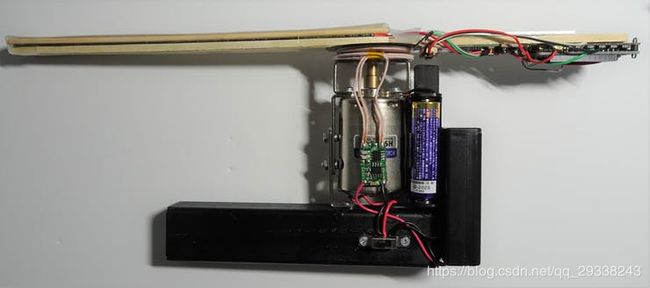使用SPRESENSE电路板的POV显示器
我使用SPRESENSE和DotStar LED编带制作了全彩POV显示器。

硬件清单
索尼Spresense主板(主板及扩展件)
QTR-1A反射传感器
DotStar数字LED编带
DFRobot无线充电模块5V / 1A
直流电机RS-540SH
SPRESENSE迷你扩展板
电压电平转换器
软件应用程序和在线服务
Arduino IDE
故事
我使用SPRESENSE、无线充电模块和DotStar LED编带制作了全彩POV(视觉暂留)显示器。
搭建过程
LED胶带、SPRESENSE和反射传感器安装在旋转组件上,并且LED编带采用DotStar。使用无线充电模块执行对旋转部件的无线供电过程。
一节AA电池用于电机供电,三节AA电池用于向旋转部件提供无线电源。
POV显示设备
电机采用金属配件固定,手柄采用黑色木材制成,电池插座和电源开/关滑动开关固定。
旋转组件完全独立,如下所示。

我使用了两个Dotstar LED编带。29芯LED灯带经由SPI4进行控制。28芯LED编导由SPI5进行控制。

我敷设了一层乳白色的薄膜,用于光的传播。
电压电平转换器TXB0104用于将SPRESENSE的逻辑电平从1.8V转换为5V。

我使用无线充电模块为LED旋转组件供电。它只是将传动线圈面向电动机旋转轴,而几乎不需要执行任何操作。
Arduino IDE代码
以下库用于Dotstar.https://github.com/adafruit/Adafruit_DotStar
Adafruit_DotStar_SPI5.h是对Adafruit_DotStar.h的修改,以便能够使用SPI5。
当反射传感器检测到标记信号时,它会减小输出,因此它会在附加中断中检测到标记信号,并测量中断处理一圈所需的时间。
它通过将一圈的时间除以150使得LED闪烁切换。LED显示模式以阵列形式存储在graphics.h中。
代码
#include
#include "Adafruit_DotStar_SPI5.h"
#include
#include "graphics.h"
#define NUMPIXELS2 29 // Number of LEDs in strip
#define NUMPIXELS 57 // Number of LEDs in 2 strips
#define Frame 16
#define Div 150
#define Fclk 26000000
#define itrPin 19
int numRot = 0;
int numDiv = 0, numDiv2 = 0;
int stateDiv = 0;
unsigned long rotTime, timeOld, timeNow;
Adafruit_DotStar_SPI5 strip5 = Adafruit_DotStar_SPI5(NUMPIXELS2, DOTSTAR_BGR);
Adafruit_DotStar strip4 = Adafruit_DotStar(NUMPIXELS2, DOTSTAR_BGR);
void setup() {
Serial.begin(115200);
strip5.begin();
SPI5.beginTransaction(SPISettings(Fclk, MSBFIRST, SPI_MODE0));
strip4.begin();
SPI.beginTransaction(SPISettings(Fclk, MSBFIRST, SPI_MODE0));
strip5.clear();
strip4.clear();
strip5.show();
strip4.show();
delay(500);
attachInterrupt(digitalPinToInterrupt(itrPin), RotCount, FALLING );
}
void loop() {
if(stateDiv == 1 && micros() - timeOld > rotTime / Div * (numDiv)){
stateDiv = 0;
}
if(stateDiv == 0 && micros() - timeOld < rotTime / Div * (numDiv + 1)){
stateDiv = 1;
strip5.clear();
strip4.clear();
for(int i=0;i= Div) numDiv2 -= Div;
strip5.setPixelColor(i, pic[numRot][numDiv2][i*2]);
strip4.setPixelColor(i, pic[numRot][numDiv][i*2+1]);
}
strip5.show();
strip4.show();
numDiv++;
if(numDiv >= Div ) numDiv = 0;
}
}
void RotCount() {
timeNow = micros();
rotTime = timeNow - timeOld;
timeOld = timeNow;
numRot++;
if(numRot >= Frame) numRot = 0;
}
显示图形数据创建方法(Python)
在Python代码中创建POV显示数据“graphics.h”。可以通过GIF或静止图像创建显示数据。
# -*- coding: utf-8 -*-
import cv2
import os
import math
from PIL import Image
#Array setting
NUMPIXELS = 57 #Number of LEDs
Div = 150 #Number of divisions per lap
Bright = 30 #LED Brightness
Led0Bright = 3 #Brightness of center LED [%]
#File creation
file = open('graphics.h', 'w')
file.write('#define NUMPIXELS ' + str(NUMPIXELS) + '\n')
file.write('#define Div ' + str(Div) + '\n' + '\n')
#file.write('#define Frame ' + str(Frame) + '\n' + '\n')
file.write('const uint32_t pic [Frame][Div][NUMPIXELS] = {' + '\n')
# Read GIF file
gif_file_name = "xxx.gif"
gif = cv2.VideoCapture(gif_file_name)
#Image conversion function
def polarConv(pic, i):
imgOrgin = cv2.imread(pic) #Read image data
h, w, _ = imgOrgin.shape #Get image size
#Image reduction
imgRedu = cv2.resize(imgOrgin,(math.floor((NUMPIXELS * 2 -1)/h *w), NUMPIXELS * 2 -1))
#cv2.imwrite(str(i) + '-resize.jpg',imgRedu)
#Reduced image center coordinates
h2, w2, _ = imgRedu.shape
wC = math.floor(w2 / 2)
hC = math.floor(h2 / 2)
#Polar coordinate conversion image preparation
imgPolar = Image.new('RGB', (NUMPIXELS, Div))
#Polar transformation
file.write('\t{\n')
for j in range(0, Div):
file.write('\t\t{')
for i in range(0, hC+1):
#Get coordinate color
rP = int(imgRedu[hC + math.ceil(i * math.cos(2*math.pi/Div*j)),
wC - math.ceil(i * math.sin(2*math.pi/Div*j)), 2]
* ((100 - Led0Bright) / NUMPIXELS * i + Led0Bright) / 100 * Bright /100)
gP = int(imgRedu[hC + math.ceil(i * math.cos(2*math.pi/Div*j)),
wC - math.ceil(i * math.sin(2*math.pi/Div*j)), 1]
* ((100 - Led0Bright) / NUMPIXELS * i + Led0Bright) / 100 * Bright /100)
bP = int(imgRedu[hC + math.ceil(i * math.cos(2*math.pi/Div*j)),
wC - math.ceil(i * math.sin(2*math.pi/Div*j)), 0]
* ((100 - Led0Bright) / NUMPIXELS * i + Led0Bright) / 100 * Bright /100)
file.write('0x%02X%02X%02X' % (rP,gP,bP))
if i == hC:
file.write('},\n')
else:
file.write(', ')
imgPolar.putpixel((i,j), (rP, gP, bP))
file.write('\t},\n\n')
#Generate directory to save screen capture
dir_name = "screen_caps"
if not os.path.exists(dir_name):
os.mkdir(dir_name)
i = 0
while True:
is_success, frame = gif.read()
# Exit when the file can not be read
if not is_success:
break
# Write out to an image file
img_name = str(i) + ".jpg"
img_path = os.path.join(dir_name, img_name)
cv2.imwrite(img_path, frame)
#conversion
polarConv(img_path, i)
i += 1
file.write('};' + '\n' + '\n')
file.close()
#Inserting the number of frames at the beginning of the file
with open('graphics.h') as f:
l = f.readlines()
l.insert(0, '#define Frame ' + str(i) + '\n')
with open('graphics.h', mode='w') as f:
f.writelines(l)
测试GIF文件
我使用了以下GIF文件。帧数是16。
测试视频链接:http://v.qq.com/x/page/o08708on52f.html
推荐项目阅读:
使用SPRESENSE电路板的POV显示器
【ardunio项目】如何制作深受儿童喜爱的木制收音机
Arduino“反应计时器” - 我的孩子喜欢玩这个
ESP32项目:邮件警报
物联网植物监测仪,用 Particle Photon制作、IFTTT监测
开源NFC模块示例(一):arduino NFC近场通讯模块的简易教程和评测
开源NFC模块示例(二):与Arduino UNO开发板的配合
开源NFC模块示例(三):Arduino NFC模块使用方法分享,PN532模块,S50卡
开源NFC模块示例(四):如何制作Makerspace NFC组件管理系统
……
更多:创客项目



